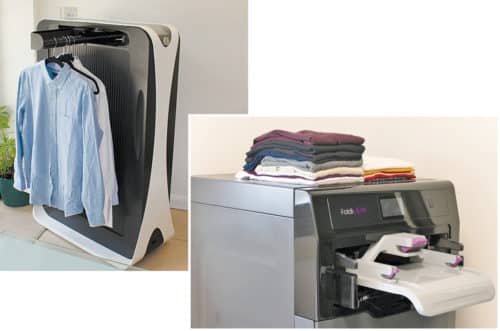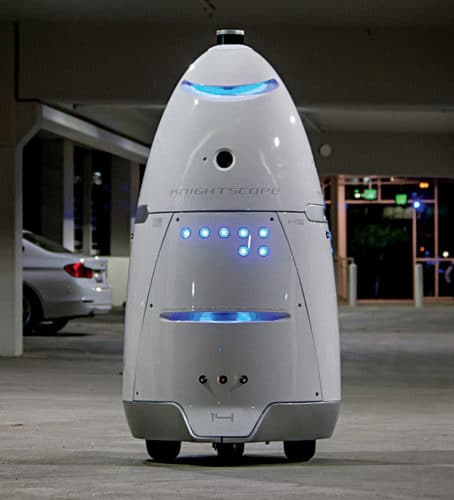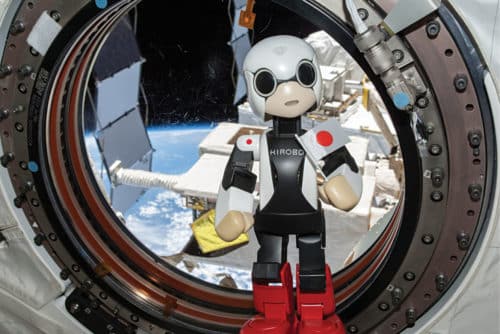Robots have become advanced enough to penetrate homes. The market for consumer robots has grown at a CAGR of seventeen per cent between 2014 and 2019
Robots are everywhere today, from industries and medical systems to defence and agriculture sectors. There are millions of robots in the world today and more are being produced every day. But did you know that robots are slowly entering and becoming popular in homes as well?
Gamma chef robot is specialised in one-pot meals. And, Moley robot can create more than 2000 dishes designed by master chefs.
Tertill, developed by Franklin Robotics, is a solar-powered weeding robot used in gardens. It identifies weeds and pulls them out without using dangerous chemicals.
Toilbit cleans toilets. This robot uses cleaning capsules and a flexible brush that can reach everywhere in the bowl.
Buddy is an open source robot for homeowners to create their own programs and tasks for it.
These are just a few examples of home robots. A home robot, also called a domestic robot, is a type of service robot that is primarily used for household functions, but it may also be used for education, entertainment or therapy purposes.
There are several household functions that are repetitive and labour-intensive. Some such home functions are cleaning, cooking, house maintenance, shopping, laundry and paying bills. Home robots are the key enabler for bringing about changes that can make a positive impact on such domestic functions.
While most domestic robots are simplistic, some are connected to home Wi-Fi networks or smart environments, and are autonomous to a large degree.
Types of domestic robots
Domestic robots are of the following types:
Indoor robots
These work around and inside homes. These can clean floors using sweeping and wet-cleaning functions. Some use wet-cleaning products like Swiffer, while others use disposable cleaning clothes for dry sweeping or reusable micro-fibre clothes for wet cleaning.
Ironing robots can be used to dry and iron clothes using hot air. Advanced ironing robots, such as Laundroid, use image analysis and artificial intelligence (AI) for this purpose.
Effie is an ironing robot that can iron twelve clothes at once. And, FoldiMate can fold and organise clothes.

Atlas is a robot built to perform such household tasks as sweeping, opening doors, climbing stairs, etc.
Cat litter robots self-clean litter boxes automatically and filter compact mass out into a built-in waste receptable lined with an ordinary plastic bag. These are fully-automatic, and shift waste within minutes to greatly reduce unpleasant odours. Litter-Robot is comfortable for both large and small cats.
Such kitchen robots as Rotimatic, Moley and Prometheus Delta can make thin pancakes (rotis) using cornflour or wheat flour in just a few minutes.
Rapiro, a Japanese humanoid robot, is a credit-card sized robot that can prepare coffee. This Linux, Raspberry Pi computing board-based robot can even carry out other tasks like personal calendar management, tracking weather and so on.
Security is an important part of home automation. Security robots like Knightscope contain a capable night-vision wide-angle camera that detects movements and intruders. Such robots can inspect places and shoot videos of suspicious activities, and send alerts via email or text message. These can store history of past alerts and videos, and are accessible from anywhere. Security robots can also be configured to go into action at any time of the day.

Outdoor robots
A robotic lawn grass cutter can cut grass in a lawn by itself after being programmed. It comes with a power unit that may be an electric motor or internal combustion engine, which provides power to the robot and allows it to move itself and its cutting blades. The robot also comes with an electronic control unit and memory unit, which allows it to cut grass repeatedly without reprogramming. It also comes with a steering unit.
There are also automated pool cleaners that clean and maintain swimming pools autonomously by scrubbing in-ground pools from the floor to the waterline in about three hours, cleaning and circulating more than 260 litres of water per minute and removing debris as small as two micrometres in size.
Window-cleaning robots are commonly used to clean windows, specifically house windows. However, these may also be used on other types of windows, such as on tall buildings and structures. Such robots come powered with an agitator located next to the cleaning pads.
Window-washing robots commonly use two magnetic modules to navigate windows as they spray the cleaning solution onto micro-fibre pads to wash them.
Robotic pets
These are AI machines made to look like animals commonly kept as pets, such as dogs, cats and birds. Robotic pets can keep elderly people from being depressed and also keep them active. One popular robotic pet is Tekno, the robotic puppy.
Toys
Robots for children have come a long way. Today, toy robots can entertain and educate. For example, MeccaNoid G15 is a toy robot built by Meccano parts. About 61cm (two-feet) tall, it is intended for children of ages above ten. Younger kids can also enjoy this robot, but they need help to build it.
Asus Zenbo is another toy robot that can read stories to children.
Social robots
In future, social robots will play a vital role at home. They can remind elderly people to take their medication and give them company when they feel lonely. Fight against social isolation is the main aim of such social companion robots. Roughly ten per cent of all British people regularly feel isolated. In fact, London has appointed a Minister of Loneliness, in January 2018, and has become the first European nation to do so.
Professor Einstein robot developed by Hanson Robotics can smile, express displeasure and stick his tongue out just as Albert Einstein did. If connected to a tablet or smartphone, Professor Einstein can play brain games or teach the user science. Moreover, it can chitchat about the weather as well as about famous people.

Presently, PARO robot is being used in more than thirty countries around the world. It is helping patients suffering from diseases like Alzheimer’s, Autism, Post Traumatic Stress Disorder (PTSD) and other forms of dementia. PARO has special sensors on its anti-bacterial and soil-resistant fur that responds to touch and makes it blink its eyes.
PARO has a black buttoned nose that has light sensors that help in light detection. The battery lasts about six hours and can be easily recharged. PARO looks at people when it is addressed, cries in response to stimuli and closes its eyes when it is scratched under the chin.
Kuri, developed by Mayfield Robotics, is a fun friend and helpful assistant. It comes with Wi-Fi, Bluetooth, 1080-pixel camera, and facial recognition and telepresence capabilities. It can talk to other robots, too. It can navigate homes, while avoiding obstacles and pets.
Hardware and software for domestic robots
Challenges and resulting improvements in home robotics technology can be contributed to the simplicity and sensitivity of the whole manufacturing process, which includes both hardware and software. Inexpensive motherboards, such as Arduino and Geekduino, are making home robots affordable and easier to build.
Infrared (IR), GPS sensors, distance sensors, robot actuators, robo controller boards, adaptors, expansion boards, power supply units, light sensors, motor controller boards, resistive flex sensors and 180-degree robot servo motors are essential hardware components used in domestic robots.
Geekduino, by Robot Geek, is a perfect microcontroller (MCU) for a robotic project. Users can easily connect sensors, servos and more to Geekduino. It is completely Arduino-compatible, and can run on the same code as Arduino.
Statistics reveal great improvements in domestic robots
The worldwide number of domestic robots will rise to 31 million by the end of 2019. Sales volumes of robots that clean floors, mow lawns and clean swimming pools will grow to about thirteen billion dollars.
In the coming years, vacuum and floor-cleaning robots will continue to make up the lion’s share of units at work in households. Sales will rise to 3.6 million units within the 2016-2019 forecast period. Vacuum and floor-cleaning robots account for 96 per cent of total domestic robot sales.
Robotic grass cutters and pool-cleaning robots rank second and third, respectively. Sales figure of assistive robots for handicapped and elderly people is expected to rise to 37,500 units from 2016 to 2019.
Robots have become advanced enough to penetrate homes. The market for consumer robots has grown at a CAGR of seventeen per cent between 2014 and 2019.
Robots are slowly entering Indian homes, too. For example, Silverlit robot, priced at ` 1875, can go after a ball and kick it, walk around the room without bumping into obstacles—it can even hold objects. Euroclean and RoboCleanz from Eureka Forbes, priced at ` 6690, can clean floors, safely wandering around the house.
By 2019, 42 million service robots will operate for domestic use. Japan is expected to have more social robots due to its high aging population. Personal robots are set to be an 18.85-billion-dollar opportunity by 2020. The Asian market for domestic robots will explode with China emerging as one of the major countries expected to provide innovative, low-cost, autonomous domestic robots in the next few years.
Robots in space
Space astronauts frequently face several issues, during their long-term stays in International Space Station. “For long-term space missions where communication with friends and families becomes difficult, PARO can prove to be a great companion,” opines Japanese industrial automation company AIST.
Japan has sent the world’s first talking social robot astronaut, Kirobo, to space. “Russia was the first to reach the moon, but Japan is the first to send a robot astronaut with the ability to communicate with humans in space,” says Yorichika Nishijima, project manager for Kirobo.

Kirobo is about 34cm tall and weighs about one kilogram. It was sent from Tanegashima Space Center on August 2013. Kirobo has broken two Guinness World Records after it returned to Japan, following its eighteen-month stay on International Space Station—first companion robot in space and highest altitude for a robot to have a conversation.
More opportunities in the future
There are many other trends catching up in the home robotics sector. For example, open source software and hardware are greatly helping those enthusiastic about home robotics, including hobbyists. With the help of these tools, they can assemble home robots at a low cost and program them according to their requirements.
Even commercial robotic companies through their R&D department are trying to develop smart robots to make domestic robots affordable. Soon, domestic robots could be available in the market at the cost of a cellphone.
Cloud-connected home robots are already becoming part of our lives. Multi-functional robotic chefs can fry, steam, bake and perform other actions without human intervention. These cloud-connected robots are likely to evolve into more advanced versions in the near future.
Owing to such technologies as AI, the Internet of Things (IoT), Big Data and others, home robots can carry out a variety of human tasks with high precision. The rise of AI technologies such as machine learning, computer vision, natural language processing and gesture controls is changing the landscape of domestic robots.
Cloud robots, 3D vision, virtual foresight and smart materials are other technologies that can help further expand the home robotics market. It is expected that embedded devices too will make these smarter. And, since technology is the main differentiator, home automation is mainly achieved using home robots.
Vinayak Ramachandra Adkoli is BE in industrial production. He has been a lecturer in mechanical department for ten years, in three different polytechnics. He is also a freelance writer and cartoonist






